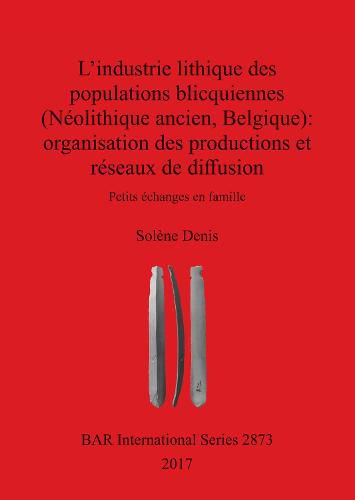Readings Newsletter
Become a Readings Member to make your shopping experience even easier.
Sign in or sign up for free!
You’re not far away from qualifying for FREE standard shipping within Australia
You’ve qualified for FREE standard shipping within Australia
The cart is loading…






This title is printed to order. This book may have been self-published. If so, we cannot guarantee the quality of the content. In the main most books will have gone through the editing process however some may not. We therefore suggest that you be aware of this before ordering this book. If in doubt check either the author or publisher’s details as we are unable to accept any returns unless they are faulty. Please contact us if you have any questions.
La culture Blicquy/Villeneuve-Saint-Germain marque la fin des traditions danubiennes (Neolithique ancien) dans le nord de la France et en Belgique. Les onze sites etudies sont localises en Belgique. Deux aires d'implantation, distantes d'une centaine de km sont distinguees (en Hainaut et en Hesbaye). La mise en ouvre d'une analyse techno-economique de l'industrie lithique blicquienne visait a repondre a un double objectif: restituer l'organisation socio-economique de la production lithique et les relations entretenues entre les differentes zones de peuplement de cette culture. Cette etude souligne la structure duale de la production lithique et suggere une specialisation intra- voire intercommunautaire de cette production laminaire. L'etude de la diffusion des matieres premieres illustre l'intensite des relations entre les villages, impliquant frequemment le deplacement de tailleurs. Ce travail souligne a nouveau l'importance des echanges dans la vie socio-economique de ces premieres communautes agro-pastorales.
In the north of France and Belgium, the Blicquy/Villeneuve-Saint-Germain culture marks the end of the Danube traditions (Early Neolithic Period). The eleven sites studied are all found in Belgium. Two settlement areas, separated by 100 km, are highlighted (in Hainaut and in Hesbaye). The author has performed an analysis of the technical and economical characteristics of the Blicquian lithic industry, in order to describe the socio-economic organisation relating to lithic production as well as the relationships between the different settlement areas of this culture. The study concludes that there were two distinct types of production and suggests some kind of specialisation in the laminar production in the community, or even among several communities. The study of the diffusion networks of siliceous raw materials illustrates the intensity of relations between villages, often involving the movement of knappers, demonstrating further the importance of exchanges for the socio-economical welfare of those agro-pastoral communities.
$9.00 standard shipping within Australia
FREE standard shipping within Australia for orders over $100.00
Express & International shipping calculated at checkout
This title is printed to order. This book may have been self-published. If so, we cannot guarantee the quality of the content. In the main most books will have gone through the editing process however some may not. We therefore suggest that you be aware of this before ordering this book. If in doubt check either the author or publisher’s details as we are unable to accept any returns unless they are faulty. Please contact us if you have any questions.
La culture Blicquy/Villeneuve-Saint-Germain marque la fin des traditions danubiennes (Neolithique ancien) dans le nord de la France et en Belgique. Les onze sites etudies sont localises en Belgique. Deux aires d'implantation, distantes d'une centaine de km sont distinguees (en Hainaut et en Hesbaye). La mise en ouvre d'une analyse techno-economique de l'industrie lithique blicquienne visait a repondre a un double objectif: restituer l'organisation socio-economique de la production lithique et les relations entretenues entre les differentes zones de peuplement de cette culture. Cette etude souligne la structure duale de la production lithique et suggere une specialisation intra- voire intercommunautaire de cette production laminaire. L'etude de la diffusion des matieres premieres illustre l'intensite des relations entre les villages, impliquant frequemment le deplacement de tailleurs. Ce travail souligne a nouveau l'importance des echanges dans la vie socio-economique de ces premieres communautes agro-pastorales.
In the north of France and Belgium, the Blicquy/Villeneuve-Saint-Germain culture marks the end of the Danube traditions (Early Neolithic Period). The eleven sites studied are all found in Belgium. Two settlement areas, separated by 100 km, are highlighted (in Hainaut and in Hesbaye). The author has performed an analysis of the technical and economical characteristics of the Blicquian lithic industry, in order to describe the socio-economic organisation relating to lithic production as well as the relationships between the different settlement areas of this culture. The study concludes that there were two distinct types of production and suggests some kind of specialisation in the laminar production in the community, or even among several communities. The study of the diffusion networks of siliceous raw materials illustrates the intensity of relations between villages, often involving the movement of knappers, demonstrating further the importance of exchanges for the socio-economical welfare of those agro-pastoral communities.